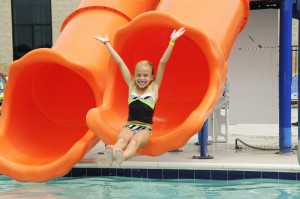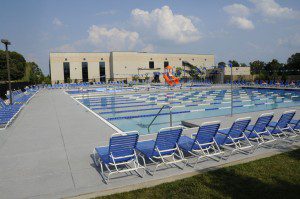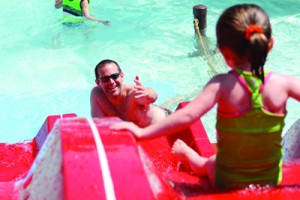The Opening Process
As spring turns to summer, clubs across the U.S. begin to open outdoor pools for members to enjoy for fitness and leisure over several months. Outdoor pools can be used heavily in sales pitches for potential members, a retention tool for long-term members, but also, if not managed properly, a minor headache for the clubs themselves.
Not all outdoor facilities are alike, and many function with some uniqueness — for example, Big Vanilla in Pasadena, Md. has a dome over its outdoor pools, to use as indoor facilities during the winter months, but in May, just in time for the summer influx of pool-goers, the dome is removed to reveal a beautiful outdoor aquatics landscape.
“Taking the dome down itself is a process,” explained Shelly Beigel, the aquatics director for Big Vanilla’s Pasadena location. “In March we double our staff. In late April and the beginning of May, we do extensive guard staff training preparing them for little kids and families. It’s a different environment than kids just coming for swim lessons when they come with families.”
During the first week of the outdoor pools being open at Big Vanilla, the club hosts a community-wide pool safety course to ensure everyone is up-to-date on how to act around a pool.
At Merritt Athletic Clubs in Baltimore, Md., which opens its pools the first week of May, it has to be completely prepared for anything that could occur — even some extremely cool nights. “We have had to have our pool heaters looked at since they have been sitting around for seven months unused,” said Andrew Barranco, the regional operations and aquatics manager at Merritt Athletic Clubs. “We have a close relationship with our outside pool company — we plan our pre-season opening with them and schedule them at the end of the season to perform our winterization on the system.”
According to Barranco, proper winterization is one of two common mistakes clubs make when preparing pools, which turns into a major problem when reopening the next season. “Two common mistakes are not closing the pool properly in the fall and waiting to the last minute to open the pool in the spring,” said Barranco. “If the pool is properly winterized in the fall, it can prevent a lot of complications come the spring time. Although simple to do, winterizing the outdoor pool is critical. Blowing lines, opening values and having the water level lowered below your skimmers are all important. If not done properly, you could have issues with cracked lines and valvues from water freezing.
Charles Luecker, the president and CEO of Lincoln Aquatics, advised clubs to research the best way to winterize its pool based on geographic location. “Some places, like Minnesota, have to drain pools completely so it doesn’t turn into a block of ice,” he said. “In the sun-belt, clubs really don’t need to worry about draining pools completely, but they still need to maintain the water in the pools. Some clubs will let the water go completely green. I recommend continuing to add chlorine even when the pool isn’t in use.”
Luecker also recommends that clubs don’t wait until the last minute to close or open a pool. He said Lincoln Aquatics’ busy season begins in early March when clubs begin ordering supplies. According to Luecker, clubs shouldn’t be purchasing large amounts of supplies during the summer, but they should order what they will need and have it on hand by May, at the latest.
“Allowing enough time to fix any issues and clean the pool before opening is important,” said Barranco. “If there are issues you want to be able to identify them early and correct them before your inspection and opening date. Having a consistent pool manager each year can help to make sure these things are planned out and done correctly. When there is a turnover, sometimes there is a learning curve as well.”

Harnessing the Heat
For Big Vanilla, which doubles its outdoor pools as indoor pools via the dome in the winter, programming also becomes a hassle when transitioning the seasons. “To remove or install the dome, we close for five days,” explained Linda Fabian, the aquatics director for the Big Vanilla Arnold, Md. location. “During those five days, there are different tasks. On day one, we remove everything from the deck, including water fountains and handrails. During day two and three, large tarps are laid across the pool and large fans are put in place to dry out the area for the two days. Day four, the dome is dropped or installed, and on day five, everything is put back on the deck, cleaned and ready for reopening.”
Immediately following removing the dome, Big Vanilla encounters a new set of issues. “Our chlorine starts evaporating quickly, where in the winter this isn’t an issue,” explained Beigel. The Cyanuric Acid (CYA) level must be monitored more closely as the pool adjusts.
“Our biggest challenge is in May and September, keeping the pool heated with the dome off,” said Beigel. “In Maryland that is tough because we can still have a 50-60 degree night. The competition pool we keep between 80-82 degrees and we have a therapy pool we try and keep at 86 degrees.”
Big Vanilla uses a “liquid blanket” to help keep the pool from losing its heat during hours in the night after the heaters shut off. Liquid blanket, otherwise known as Heatsavr, a product Big V purchased from Flexible Solutions, forms a thin layer over the top of the water that helps retain heat as the temperature drops. “The biggest challenge we have with our heaters with the dome off is because they run harder and longer,” continued Beigel. “Sometimes they do overheat because they run so long. Sometimes they will kick off at night and we will have to come in early. But, liquid blanket helps us not to lose so much water temperature. When [the heaters] turn off at 12 a.m. or 1 a.m. the Heatsavr helps us save the heat. When we didn’t use Heatsavr we could lose seven degrees or more. This can be a big change in the therapy pools and competition pools.”
“Essentially, the patented liquid spreads across the surface of the pool water and creates a barrier to reduce the rate of evaporation,” explained Monique Nelson, a liquid pool cover expert for Flexible Solutions. “Since approximately 70 percent of heat loss is due to evaporation, by using Heatsavr, the heat will stay in the pool water. With a liquid cover, there aren’t any heavy, awkward blankets to apply. It spreads itself across the pool and works 24 hours a day, even when the pool is being used. It is the only liquid solar cover that has been tested for efficiency and safety — and, has been approved for use in commercial swimming pools, both indoor and outdoor.”
Big Vanilla uses warm days in early May to help warm the pools and give the heaters a break. “It’s something we monitor every day throughout the year,” said Beigel. “It takes eight to 10 hours for the temperature to change. When it gets really warm, we won’t put in the liquid blanket.” The liquid blanket is injected into the pools either automatically or manually. As the temperature changes, Beigel changes the injection to manual and uses it as needed. “It’s something we work very hard at,” she continued. “It took a long time to get confident on where the settings need to be. It did take a summer.”
Beigel, now into her third year at Big Vanilla, has charts and notes that outline every level of every heater, how much liquid blanket has been used, the temperatures of the pools and the corresponding fluctuations in outdoor temperature for every day during her three years. “It’s a learning process,” she said. “I talked to people in Minnesota, and people in Colorado to make the transition.” It was searching out clubs in those other states that also used domes that helped her learn quickly. “Because our dome is so big, it was definitely a lot of research. Our first summer, it was hard. It took to taking a lot of notes, but now that we have, it’s actually quite manageable — so, people call me now,” she laughed.
As the summer progresses and people spend vast amounts of time at the pool, operations begin to change — however, not necessarily in terms of the pools themselves. “As the summer goes on, two things happen,” explained Barranco. “Younger swimmers gain confidence in the water and will push themselves to go in too deep for them to safely swim. The other thing that can happen is lifeguards get too comfortable and, for lack of a better word, get lazy as the summer goes on. This is a dangerous combination. It is important to not only hold regular in-service trainings with lifeguards, but also constantly observe their scanning habits and behaviors.”
“Most people that come to the club haven’t been there all year,” said Beigel. “The biggest task is training our customer base.” Big V works with front desk attendants to instruct members on pool safety throughout the year, but most importantly during the first months. Beigel said it’s difficult when customers, both children and adults, enter extremely excited. The front desk has to be able to be calming and direct to ensure that the message is conveyed to everyone.
The outdoor pool can be a boost to your bottom line, a sales point and a retention tool. If managed properly, the outdoor pool can provide you all these possibilities with minimal headache. Spend time meeting with your aquatic managers this month to make sure everyone is on the same page. Should the opening process begin earlier in the year? What can your club do to close the pool at the end of the season more efficiently? Remember, the way you close will affect the way you open for the next season.
Pools can be enjoyable for everyone involved. Just invest the necessary time and energy to ensure that your club, and your community, can be entertained in and around your pools all season in a safe and responsible fashion.
By Tyler Montgomery















